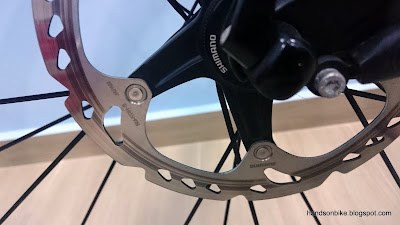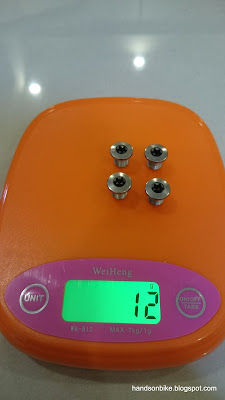1) Want to try out component with new feature
2) Discount on website
3) Replacement for worn out component
4) Upgrade on existing component
5) Improve fitting on existing bike
In this case, I decided to get a new crankset because of reason 2 and reason 5. I came across this article regarding the bio-mechanics of cycling, and it discussed the crank arm length in detail. Seems that most bikes in the market are actually equipped with crank arm lengths that are too long for most people.
Link below:
http://bikedynamics.co.uk/FitGuidecranks.htm
In summary, for a person with height of 168cm (me), I should be using a crank arm length of 165mm. However, I have been using crank arm length of 170mm for as long as I can remember, due to the fact that it is the default length for most bikes in my size, and is also the most common length available.
Although I don't have a problem using 170mm crank arm length, I feel that when I am in the drops on the Merida road bike, it feels like my hip angle is too small when my knee is at the top of the pedaling stroke.
At the same time, I also came across a great online offer from Rodalink, where they are selling the Dura-Ace 7900 crankset for only $200+, when it usually costs $600+. The catch is that it is 53/39T, and also has 165mm crank arm length. Most of the time, people will not buy a crankset with 165mm crank arm length. However, in this case, it is perfect as it gives me a chance to test out a shorter crank arm length, and I am also getting a great deal on a Dura-Ace crankset.
Although this Dura-Ace 7900 crankset is 2 generations old, having already been replaced by the newer 9000 and R9100 series, it is still iconic, with the two-tone surface treatment and integrated chain ring appearance.
With that, I ordered the Dura-Ace 7900 crankset with a 165mm crank arm length, and will install it on the Merida Scultura 5000 to try out.
Since the crank arm is 5mm shorter, it also means that I can raise the saddle 5mm higher, and still get the same leg extension at the bottom of the pedaling stroke.
Current setup on the Merida road bike. Dura-Ace 9000 crankset with 170mm crank arm length.
With the Dura-Ace 7900 crankset, one difference is that 7900 is for 10 speed, while Dura-Ace 9000 is for 11 speed. There is a small difference in distance between the chain rings, but it should not affect the shifting performance greatly.
Let's take a look at the new (old?) Dura-Ace 7900 crankset!
Unboxing the Dura-Ace 7900 crankset! Always a wonderful experience
Iconic 5 arm crankset with integrated chain ring appearance
Polished aluminium! Still so shiny even after a few years of storage.
Weighs only 643 grams for the whole crankset. The weight is in between Dura-Ace 9000 and Ultegra 6800.
During installation, I found that I had to move the front derailleur upwards, as the previous setting was for the 50/34T crankset, while this Dura-Ace 7900 crankset has 53/39T. Also, the chain had to be lengthened due to the larger 53T chainring. Not a straightforward crankset swap due to the different chain ring sizes.
Installed on the bike, with the Ultegra 6870 Di2 FD moved upwards
Swapping a Dura-Ace crankset for another
Installation completed!
After testing it out for a couple of months, I found that there is some difference in the pedaling stroke. When using the drops, the knees will not come up as high, and the hip angle is not so tight, making it more comfortable when using the drops. When using the hoods, there is no noticeable difference as the hip angle does not get so tight.
Although there is a difference, this difference is quite small, and I am comfortable with using either 165mm or 170mm crankarm length. Perhaps for long distance riding or high cadence riding there will be a difference over longer periods of time.
In conclusion, using a shorter 165mm crank arm length will make a difference only if you are using the drops frequently, and if you are concerned with getting maximum pedaling efficiency and perfect bike fitting. Otherwise, it is OK to stick with 170mm crank arm lengths for most purposes.





















































